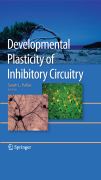
Neuroscience has long been focused on understanding neural plasticity in bothdevelopment and adulthood. Experimental work in this area has focused almost entirely on plasticity at excitatory synapses. A growing body of evidence suggests that plasticity at inhibitory GABAergic and glycinergic synapses is of critical importance during both development and aging. The book brings together the work of researchers investigating inhibitory plasticity at many levels of analysis and in several different preparations. This topic is of wide relevance across a number of different areas of research in neuroscience and neurology. Medical problems such as epilepsy, mental illness, drug abuse, and movement disorders can result from malfunctioning inhibitory circuits. Further, the maturation of inhibitory circuits may trigger the onset of critical periods of neural circuit plasticity, raising the possibility that such plastici periods could be reactivated for medical benefit by manipulating inhibitory circuitry. Presents latest knowledge in order to reconcile conflicting data and to promotefurther progress Reports on inhibitory plasticity that has a behavioral implication Seeks to promote further studies to help clarify excitation-independentmechanisms underlying strengthening in inhibitory connections INDICE: History of the field.- Tools for the study of inhibitory plasticity.- Migratory pathways of inhibitory interneurons in cerebral cortex.- Changesin the function of GABAergic synapses during development.- Homeostatic plasticity of cortical circuits demonstrated in vitro and in vivo.- Role of spontaneous activity in the maturation of GABAergic synapses in spinal circuits.- Roleof inhibitory plasticity in sound localization circuits.- Activity-dependent plasticity of inhibition underlying complex response properties in the visual and auditory systems.- Inhibitory circuits underlying critical period plasticity in visual cortex.- Endocannabinoids underlie inhibitory plasticity in the cerebellum and hippocampus.- Co-release of neurotransmitters as a mechanism forinhibitory plasticity.- LTD as a mechanism for inhibitory plasticity.- Developmental switches in GABAergic signalling as a mechanism for inhibitory plasticity.- What is the role of inhibitory plasticity in normal development and neurological disease.
- ISBN: 978-1-4419-1242-8
- Editorial: Springer
- Encuadernacion: Cartoné
- Páginas: 320
- Fecha Publicación: 01/12/2009
- Nº Volúmenes: 1
- Idioma: Inglés
